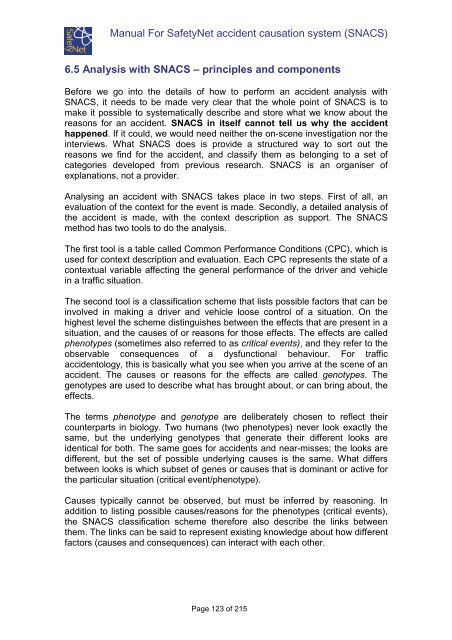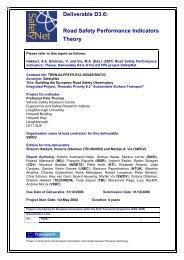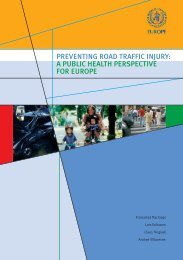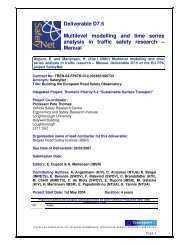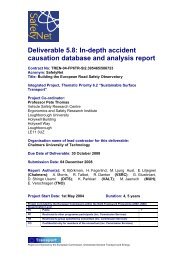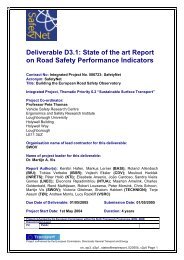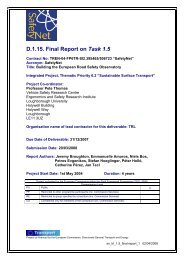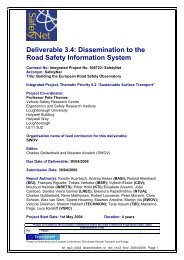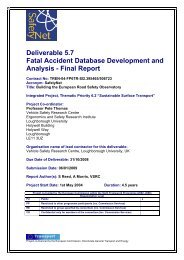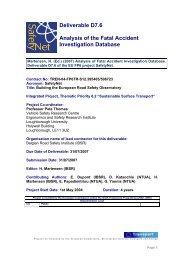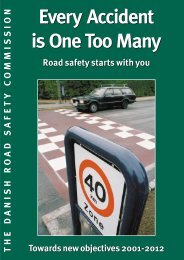Glossary of Data Variables for Fatal and accident causation ... - ERSO
Glossary of Data Variables for Fatal and accident causation ... - ERSO
Glossary of Data Variables for Fatal and accident causation ... - ERSO
Create successful ePaper yourself
Turn your PDF publications into a flip-book with our unique Google optimized e-Paper software.
Manual For SafetyNet <strong>accident</strong> <strong>causation</strong> system (SNACS)<br />
6.5 Analysis with SNACS – principles <strong>and</strong> components<br />
Be<strong>for</strong>e we go into the details <strong>of</strong> how to per<strong>for</strong>m an <strong>accident</strong> analysis with<br />
SNACS, it needs to be made very clear that the whole point <strong>of</strong> SNACS is to<br />
make it possible to systematically describe <strong>and</strong> store what we know about the<br />
reasons <strong>for</strong> an <strong>accident</strong>. SNACS in itself cannot tell us why the <strong>accident</strong><br />
happened. If it could, we would need neither the on-scene investigation nor the<br />
interviews. What SNACS does is provide a structured way to sort out the<br />
reasons we find <strong>for</strong> the <strong>accident</strong>, <strong>and</strong> classify them as belonging to a set <strong>of</strong><br />
categories developed from previous research. SNACS is an organiser <strong>of</strong><br />
explanations, not a provider.<br />
Analysing an <strong>accident</strong> with SNACS takes place in two steps. First <strong>of</strong> all, an<br />
evaluation <strong>of</strong> the context <strong>for</strong> the event is made. Secondly, a detailed analysis <strong>of</strong><br />
the <strong>accident</strong> is made, with the context description as support. The SNACS<br />
method has two tools to do the analysis.<br />
The first tool is a table called Common Per<strong>for</strong>mance Conditions (CPC), which is<br />
used <strong>for</strong> context description <strong>and</strong> evaluation. Each CPC represents the state <strong>of</strong> a<br />
contextual variable affecting the general per<strong>for</strong>mance <strong>of</strong> the driver <strong>and</strong> vehicle<br />
in a traffic situation.<br />
The second tool is a classification scheme that lists possible factors that can be<br />
involved in making a driver <strong>and</strong> vehicle loose control <strong>of</strong> a situation. On the<br />
highest level the scheme distinguishes between the effects that are present in a<br />
situation, <strong>and</strong> the causes <strong>of</strong> or reasons <strong>for</strong> those effects. The effects are called<br />
phenotypes (sometimes also referred to as critical events), <strong>and</strong> they refer to the<br />
observable consequences <strong>of</strong> a dysfunctional behaviour. For traffic<br />
<strong>accident</strong>ology, this is basically what you see when you arrive at the scene <strong>of</strong> an<br />
<strong>accident</strong>. The causes or reasons <strong>for</strong> the effects are called genotypes. The<br />
genotypes are used to describe what has brought about, or can bring about, the<br />
effects.<br />
The terms phenotype <strong>and</strong> genotype are deliberately chosen to reflect their<br />
counterparts in biology. Two humans (two phenotypes) never look exactly the<br />
same, but the underlying genotypes that generate their different looks are<br />
identical <strong>for</strong> both. The same goes <strong>for</strong> <strong>accident</strong>s <strong>and</strong> near-misses; the looks are<br />
different, but the set <strong>of</strong> possible underlying causes is the same. What differs<br />
between looks is which subset <strong>of</strong> genes or causes that is dominant or active <strong>for</strong><br />
the particular situation (critical event/phenotype).<br />
Causes typically cannot be observed, but must be inferred by reasoning. In<br />
addition to listing possible causes/reasons <strong>for</strong> the phenotypes (critical events),<br />
the SNACS classification scheme there<strong>for</strong>e also describe the links between<br />
them. The links can be said to represent existing knowledge about how different<br />
factors (causes <strong>and</strong> consequences) can interact with each other.<br />
Page 123 <strong>of</strong> 215


